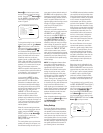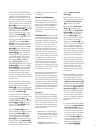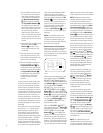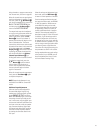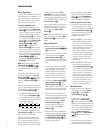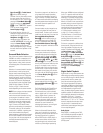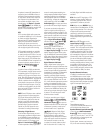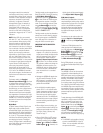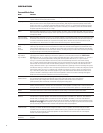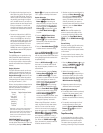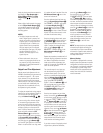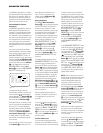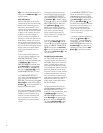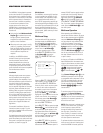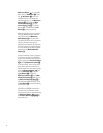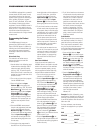
34
OPERATION
Surround Mode Chart
MODE FEATURES
Dolby Digital Available only with digital input sources encoded with Dolby Digital data. It provides up to five separate main audio channels and
a special dedicated Low-Frequency Effects channel.
Dolby Digital EX Available when the receiver is configured for 6.1/7.1-channel operation, Dolby Digital EX is the latest version of Dolby Digital.
When used with movies or other programs that have special encoding, Dolby Digital EX reproduces specially encoded sound
tracks so that a full 6.1/7.1 sound field is available. When the receiver is set for 6.1/7.1 operation and a Dolby Digital signal is
present, the EX mode is automatically selected. Even if specific EX encoding is not available to provide the additional channel,
the special algorithms will derive a 6.1/7.1 output.
DTS 5.1 When the speaker configuration is set for 5.1-channel operation, the DTS 5.1 mode is available when DVD, audio-only music or
laser discs encoded with DTS data are played. DTS 5.1 provides up to five separate main audio channels and a special dedicated
low-frequency channel.
DTS-ES 6.1 Matrix When the speaker configuration is set for 6.1/7.1 operation, playback of a DTS-encoded program source will automatically trigger
DTS-ES 6.1 Discrete the selection of one of the two DTS-ES modes. Newer discs with special DTS-ES discrete encoding will be decoded to provide
six discrete, full-bandwidth channels plus a separate low-frequency channel. All other DTS discs will be decoded using the
DTS-ES Matrix mode, which creates a 6.1-channel sound field from the original 5.1-channel soundtrack.
Dolby Pro Logic II Dolby Pro Logic II is the latest version of Dolby Laboratory’s benchmark surround technology that decodes full-range, discrete left,
Movie center right, right surround and left surround channels from either matrix surround-encoded programs and conventional stereo
Music sources when an analog input is in use. The Dolby Pro Logic II Movie mode is optimized for movie soundtracks, while the Dolby
Emulation Pro Logic II Music mode should be used with musical selections. The Dolby Pro Logic II Emulation mode re-creates original Dolby
Pro Logic processing for those who prefer that presentation.
Logic 7 Cinema Logic 7 is an advanced mode that extracts the maximum surround information from either surround-encoded programs or
Logic 7 Music conventional stereo material. Depending on the number of speakers in use and the selection made in the SURROUND
Logic 7 Enhance SELECT menu, the “5.1” versions of Logic 7 modes are available when the 5.1 option is chosen, while the “7.1” versions of
Logic 7 produce a full sound field presentation, including back surround speakers when the “6.1/7.1” option is chosen.
The Logic 7 C (or Cinema) mode should be used with any source that contains Dolby Surround or similar matrix encoding.
Logic 7 C delivers increased center-channel intelligibility, and more accurate placement of sounds with fades and pans that are
much smoother and more realistic than with other decoding techniques. The Logic 7 M or Music mode should be used with
analog or PCM stereo sources. Logic 7 M enhances the listening experience by presenting a wider front soundstage and greater
rear ambience. Both Logic 7 modes also direct low-frequency information to the subwoofer (if installed and configured) to deliver
maximum bass impact. The Logic 7 E (or Enhance) mode, available only when the 5.1 option is chosen, is an extension of the
Logic 7 mode that is primarily used with musical programs. Logic 7 adds additional bass enhancement that circulates low fre
quencies in the 40Hz to 120Hz range to the front and surround speakers to deliver a less localized soundstage that appears
broader and wider than when the subwoofer is the sole source of bass energy.
DTS Neo:6 Cinema These two modes are available when any analog source is playing to create a six-channel surround presentation
DTS Neo:6 Music from conventional matrix-encoded and traditional stereo sources. Select the Cinema version of Neo:6 when a
program with any type of analog matrix surround encoding is present. Select the Music version of Neo:6 for
optimal processing when a nonencoded, two-channel stereo program is being played.
Dolby 3 Stereo Uses the information contained in a surround-encoded or two-channel stereo program to create center-channel information. In
addition, the information that is normally sent to the rear-channel surround speakers is carefully mixed in with the front-left and
front-right channels for increased realism. Use this mode when you have a center channel speaker but no surround speakers.
Theater The Theater mode creates a sound field that resembles the acoustic feeling of a standard live-performance theater.
Hall 1, Hall 2 The two Hall modes create sound fields that resemble a small (Hall 1) and medium-sized (Hall 2) concert hall.
VMAx Near When only the two front-channel loudspeakers are used, JBL’s patented VMAx mode delivers a three-dimensional sound space
VMAx Far with the illusion of “phantom speakers” at the center and surround positions. The VMAx N, or “Near Field,” mode should be
selected when your listening position is less than five feet from the speakers. The VMAx F, or “Far Field,” mode should be
selected when your listening position is greater than five feet from the speakers. The VMAx modes are also available using the
Headphones Output 4. When head phones are being used, the Far Field mode will appear to push the sound field away from
your ears, reducing the “inside the head” sensation often experienced when using headphones.
5-Channel Stereo This mode takes advantage of multiple speakers to place a stereo signal at both the front and back of a room.
7-Channel Stereo Depending on whether the AVR has been configured for either 5.1 or 6.1/7.1 operation, one of these modes, but not both,
is available at any time. Ideal for playing music in situations such as a party, it places the same signal at the front-left and
surround-left, and front-right and surround-right speakers. The center channel is fed a summed mono mix of the in-phase
material of the left and right channels.
Surround This mode turns off all surround processing and presents the pure left- and right-channel presentation of two-channel stereo
Off (Stereo) programs.



